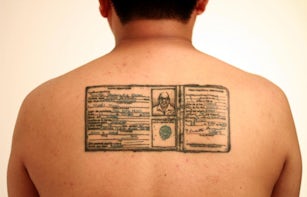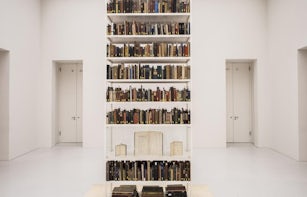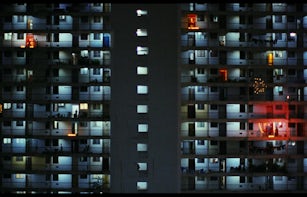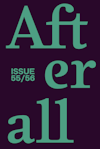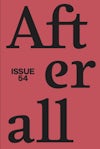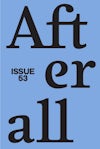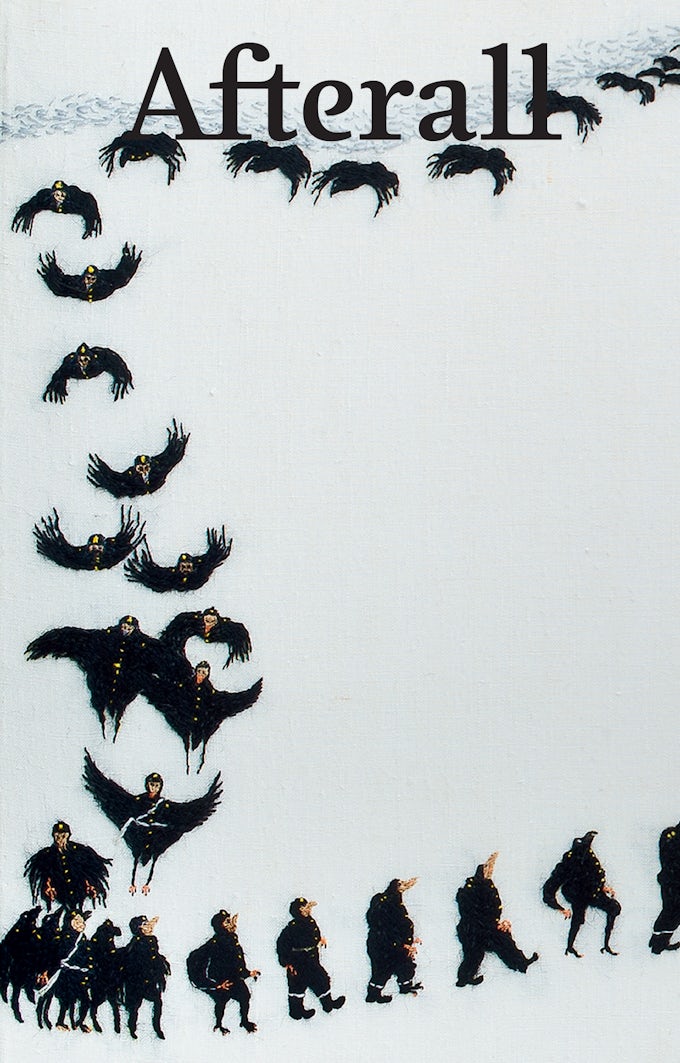
Issue 45
Spring/Summer 2018
Afterall is pleased to present issue 45, Spring/Summer 2018. Drawing much from a critical understanding of documenta 14, and featuring the work of Rasheed Araeen, Rebecca Belmore, Yee I-Lann and Britta Marakatt-Labba, Afterall 45 considers ‘Scenes of Discord: Unlearning History and Healing Wounds’.
Editors: Ana Bilbao, Charles Esche, Anders Kreuger, David Morris, Wanda Nanibush, Charles Stankievech.
Founding editors: Charles Esche, Mark Lewis.
Table of contents
Foreword
Contextual Essays
- Thinking and Engaging with the Decolonial: A Conversation Between Walter D. Mignolo and Wanda Nanibush – Walter D. Mignolo & Wanda Nanibush
- The Art of Gentrification: The Lisbon Version – Ana Teixeira Pinto
- a year or more of darkness, a few hundred years without day – Alec Finlay
Artists
Britta Marakatt-Labba
- Britta Marakatt-Labba: ‘Images Are Always Stories’ – Anders Kreuger
- Stories Created in Stitches – Gunvor Guttorm
Rebecca Belmore
- Rebecca Belmore: Material Relations – Julia Bryan-Wilson
- Picking Up a Long Line – cheyanne turions
- In Memoriam: Chris Wainwright – Mark Lewis & Kendra Sullivan
- /Cloud/ Watching or Portrait of a Young Artist in 1990s Kuala Lumpur – Simon Soon
Rasheed Araeen
- Words Toting Their Contexts: Rasheed Araeen’s Criticism of Racial Relations Bureaucracy – Nizan Shaked
- In Conversation with Rasheed Araeen – Nick Aikens
Events, Works, Exhibitions
- Witnessing the Prosecution – Anthony Gardner
- Subtitling Communism: Beneath Anri Sala’s Intervista – Vincent W. J. van Gerven Oei
- Ground Provisions – Stefano Harney & Tonika Sealy Thompson
Foreword
Written by Charles Esche
Afterall is approaching its twentieth year of publication. Over the last two decades, both the content and the guiding philosophies of the journal have undergone significant change, driven by what has happened to art and its relation to the wider world. This issue is a perfect example of how far Afterall has travelled – and where it finds itself today – drawing much inspiration from a critical understanding of documenta 14, an exhibition that might still take some years to unfold fully.
Without enumerating all the steps along the way, it is obvious that the belated emergence of a new geopolitics in the art world has profoundly affected our discussions within the editorial team. Two decades ago, our map of the art world was largely white and bourgeois. On the one hand, it traced the route of North Atlantic modern and avant-garde legacies to the present. On the other, Afterall upheld a politics critical of social democracy, which had compromised itself in the 1990s. Yet it remained sympathetic to the broad tradition of well-meaning leftism that, at least nominally, dominated the art world. Now, both those positions seem redundant, ruins of a world that was neither desirable nor sustainable, however dark the future might look today. In their place, very little, if any, equivalent ideological force has emerged. Indeed, the idea of replacing Western modern ideology is itself caught in the trap of being a modernist demand. Instead, particularities, specificities and exceptions have emerged to construct a pattern in which respect for difference is fundamental. These changes cross the old left-right divisions of the modern political project – identity politics has purchase on people who would self-identify as left or right, and personal allegiances set the tone in most cultural debates. Demands to be heard by indigenous or national group cultures can represent liberation from North Atlantic imperial projects in Canada, Catalonia or Scotland and at the same time serve as a shield for white, male, conservative privilege in Britain, Spain or the United States. Amidst all this shifting ground, there are new alliances and treaties constantly being made and unmade. Individualism is hailed by libertarians and exploited by precarious capitalism, yet individual bodies are under enormous psychological and commercial pressure to make choices about how and with whom they want to associate themselves and to what collective sense of belonging they would like to adhere.
These confused and conflicted patterns of the present are what Afterall tries uncertainly to map in its choices of artists, writers and topics. In this issue, two artists who both have long histories of struggle with modern art and modern/colonial patterns of thought are given substantial space. Rasheed Araeen is undoubtedly one of the artists who has done the most to force the British art world to be aware of its imperial and white supremacist instincts. Nizan Shaked and Nick Aikens outline the way in which Araeen’s work, as an artist addressing and modifying Euro-modern aesthetics, is exemplary; and, in defining his role in publishing and commissioning texts considered unpublishable by the guardians of the modern art narrative, has been slowly but ultimately transformative of the Anglo-context. Rebecca Belmore, from a younger generation and with an impressive practice behind her, has also faced the struggle for recognition, as an Anishinaabe artist working in a white settler region. She has maintained an agonistic relationship to her official government, skilfully unpacked in cheyanne turions’s survey and Julia Bryan- Wilson’s close study of Biinjiya’iing Onji (From Inside, 2017). This work was an example of a pivotal contribution to the ambitions of the documenta 14 exhibition, as was the extensive project comprising paintings, reading room and soup kitchen by Araeen. The last edition of Europe’s quinquennial mega-exhibition successfully captured the peculiarly introspective discomfort of Europe’s cultural condition, in which nostalgia, anxiety and feelings of ethnic superiority vie for supremacy. Documenta’s relations beyond the North Atlantic, addressed in Anthony Gardner’s thoughtful text, is one of the few considerations of the exhibition to take the curators at their word rather than condemn them for things the market or the modern establishment wanted it to be.
Purchase
The publication is available for purchase. If you would like specific articles only, it is also available individually and to be downloaded as PDFs.
Purchase full publication
Buy via University of Chicago Press
Buy via Central Books
Purchase individual articles
Buy via University of Chicago Press
